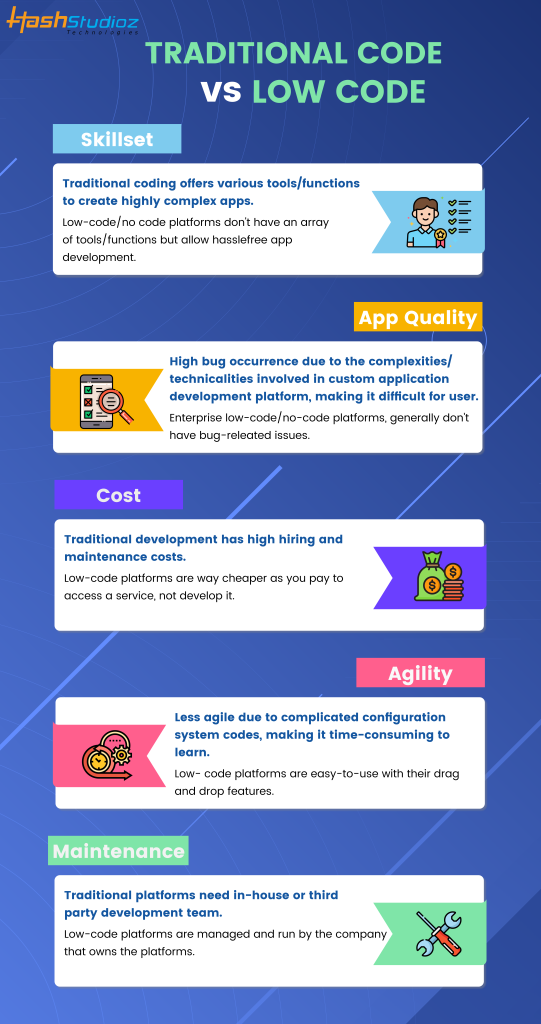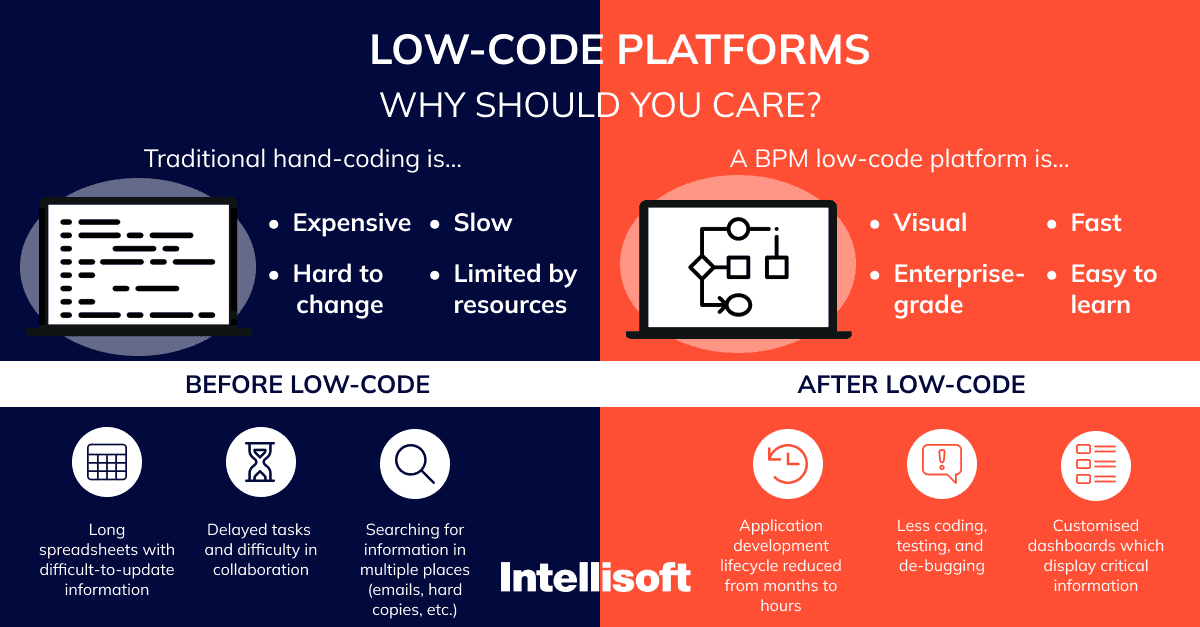Recommended Suggestions To Selecting Legacy application modernization with Low-code
The Accessibility Of Low-Code Applications Is Among The Major Advantages.App development that is low-code improves accessibility for non-developers (often referred to "citizen-developers") due to certain key aspects.
Drag-and-drop Builders: Lowcode platforms include drag-anddrop interfaces to enable non-developers to create visually appealing applications without the need for codes. Development is now easier for those who have no technical background.
WYSIWYG editors Editors that use WYSIWYG: These "What You See is What You get" editors allow users to create workflows and interfaces that are identical to the finished version. This makes it easier to understand and use.
Simple workflow and logic
Visual Workflow modeling: Users design business processes and application logic using visual flowcharts. These models are easier to use than traditional method of programming.
Pre-built Logic Components: Low-code platforms include logic components already built (e.g. conditional loops and statements), which can be configured easily and without the need for complicated coding.
Reusable Components and Templates
Libraries of prebuilt templates: Low-code platforms typically provide templates libraries for the most popular types of applications. This gives non-developers the opportunity to start with a solid base and then modify it according to their needs.
Reusable Modules and Widgets Utilizing modular and widgets that can be reused, users can simplify the design process and reduce the need for technical expertise.
Guided Development and Tutorials:
Step-by-Step Guides: Platforms often offer a set of development guides as well as tutorials and on-screen suggestions to help non-developers with building applications.
Interactive Tutorials. Interactive, hands-on tutorials let users learn by doing.
Integration with tools already in use
Seamless Integration: Low-code platforms are designed to be easily integrated with existing business tools and systems (e.g., CRM and ERP) which allows non-developers to create applications that work with their existing workflows.
APIs and Connectors: Built-in APIs and connectors simplify the integration process, enabling non-developers to connect their applications to external services without the need for complicated coding.
Collaboration Features:
Team Collaboration Features, like real-time collaboration as well as shared workspaces, allow non-developers and professionals to work together efficiently.
Access levels can be set for non-developers in order to ensure that they are able contribute to development, without compromising security.
Automated Debugging, Testing and Debugging
Low-code platforms come with tools to test and debug that are built-in. They automate this process so it is easier for nondevelopers to ensure their apps function.
Error Highlighting: When problems occur the platform highlights any errors and suggests fixes, guiding non-developers through troubleshooting techniques.
The capacity of low-code software to allow development for non-developers is its biggest advantage. Through providing an intuitive, visually-guided tool and experiences, low-code platforms allow business owners to actively participate and maintain applications. Have a look at the top more about Low-code Platform for application development for more examples including low code development platforms, cloud software applications, develop mobile application, push notifications, driver jdbc, build a docker container, sso azure, low code platforms, jdbc server, mobile app development platforms and more.

Benefits Of Developing Applications Using Low-Code In Terms Of Governance And Security
Low-code applications offer a number of advantages in terms of security and governance, both of which is essential to ensure that the application is compliant, secure, and well-managed throughout their lifespan. These are the main benefits.
Unified Management Console: Low-code applications typically provide a centralized management console, where administrators are able to supervise and manage all applications, ensuring consistent governance across the entire organization.
Role-Based Access Control RBAC: These platforms are equipped with robust controls based on role that allow administrators to set access rules. Only authorized users are able to modify or access certain areas of the program.
Compliance and Regulatory Adherence:
The advantages of conformity: Many platforms using low-code have been designed to be in line to industry standards. These platforms offer frameworks and tools that ensure that the application is in line with these regulations.
Audit Trails: Many organizations use comprehensive log and audit trail systems, which allow them to keep track of changes make, track access and assure that they are in compliance with internal as well as external laws.
Improve Security Measures
Data Encryption : Low-code platform typically provide built-in encryption of data in transit and at rest. This ensures that data sensitive information is protected.
Security Certificates: Many low-code providers have a security certificates (e.g. ISO 27001 and SOC 2) which demonstrate that they are adhering to strict security guidelines. They offer an additional security level to their clients.
Automated security updates:
Regular Patching and Updating: Lowcode platforms usually provide regular updates to security. These patches protect software from the latest threats without requiring the involvement of developers.
Security Monitoring - Continuous security monitoring is often comprised. This gives real-time information and alerts on security risks that could be a threat.
Data Governance
Data Access Policies: These platforms allow organizations to define and enforce policies on data access to ensure that data is accessible to authorized users and is used appropriately.
Data Masking and Anonymization Inbuilt tools for masking data and anonymization protect sensitive information, especially in development and testing environments.
Consistent Lifecycle Management of Applications:
Pipelines for Deployment and Development Low-code platforms usually offer integrated development and deployment pipelines which include security checks, which ensure security remains intact throughout the application lifecycle.
Version Control: An integrated version control enables the management of modifications. It also guarantees that any changes made to the software are monitored and, if necessary, reversed. This helps maintain the security of the program.
User Authentication & Authorization
Single Sign-On (SSO). Support for advanced authentication and single sign-on makes it easier and increases security.
Multi-Factor Authentication (MFA) A number of platforms offer built-in support for multi-factor authentication. This adds an additional layer of security for accessing applications.
Policy Enforcement Monitoring and Compliance:
Low-code platforms come with policy templates predefined that can help organizations implement governance policies and security policies.
Compliance Monitoring Tools - These instruments provide constant monitoring of compliance status and offer reporting, making it easy to identify and resolve potential issues.
Integration with Existing Security Infrastructure
Seamless Integration: Platforms that use low-code technology are built to integrate seamlessly with existing tools and infrastructure, such as SIEM (Security Information and Event Management solutions) and firewalls.
API Security API Security features ensure integrations with external systems, securing information and ensuring integrity of the applications.
Training and best practices:
Guided Best Practices: Many platforms provide guidelines and best practices for secure application development, helping non-developers adhere to security guidelines.
Security Training Some low code companies offer security resources and training to users in order to help them understand how to create and maintain secure applications.
Overall, low-code application developers offer security and governance benefit which allows them to create and manage applications in a controlled, regulated and secure way. These platforms provide the frameworks and tools needed to protect sensitive data and enforce policies. They also maintain regulatory compliance, all while simplifying administration and supervision of the development process. Have a look at the best Legacy application modernization with Low-code for more examples including rapid app development, rapid application design, jdbc server, push alerts, rad application development, multiplatform mobile app development, driver jdbc, cross platform mobile development, rad application development, jdbc server and more.

Benefits Of Low-Code App Development With Respect To Limitations And Customization
Low-code development is an approach that is balanced and offers substantial advantages when it comes to addressing limitations and allowing for modification. Here are a few main benefits:Handling limitations:
Beating Complexity Barriers
Simple development: Low-code platforms streamline the process by providing templates and pre-built elements. This helps speed up application deployment, even for complex ones.
Guided Workflows Many platforms offer workflows and wizards that help developers through complicated processes. This helps to reduce the possibility of error, while ensuring uniformity.
Scalability Solutions
Scalability integrated into Low-Code platforms: Low-code platforms are often equipped with features that enable scaling architecture. This allows applications to take on more load without major redevelopment.
Performance Monitoring: The instruments that track and optimize performance help to ensure that applications are efficient even as they expand.
Security and Compliance
Integrated security features Low-code platform come with built-in measures of security such as encryption. Access control that is based on roles and automated compliance checks, addressing the most common security issues.
Regular Updates: Platforms often change their security protocols and compliance measures. This helps ensure that applications are safe from threats that are constantly evolving.
Customization:
Extensibility:
Custom Code Integration : A low-code platforms typically allow for the integration of custom code (e.g. JavaScript, Python) that allows developers to expand the functionality beyond what is available in the standard features.
Custom Modules and Plugins: Developers have the option to create customized modules or plugins in order to tailor specific functions to fit unique business needs.
APIs Integration
API Support - Comprehensive support of APIs facilitates seamless integration with other systems and services and allows for complete modification.
Third Party Services: Low-code platforms typically provide pre-built connectors for well-known third-party services, making it simpler to connect and modify applications.
Flexible UX/UI:
Customizable User Interfaces: Developers can alter and create user interfaces that meet specific design and usability specifications, providing a tailored user experience.
Responsive Web Design The built-in design responsive features allow applications to be customized according to the device and screen size.
Business Logic Customization
Visual Workflow Builds Visual tools that permit the modification of workflows as well as business rules as well as to design complicated custom processes.
Platforms include conditional Logic that allows the creation of custom scripts designed to deal with specific scenarios and business rules.
Data Management:
Custom Data Models Developers can choose to develop custom data models specifically for particular applications, adjusting data handling to the specific requirements of business.
Advanced Data processing Integration and advanced data handling tools permit the customization of data analysis and usage within the application.
Balanced Limitations and Customization
Frameworks, Standards and Standards:
Best Practices for Compliance: Low-code platforms encourage the use of industry-leading practices and standards, which assists in maintaining high-quality robust, and secure applications.
Governance Frameworks. The built-in governance frameworks can help ensure that any modifications are not damaging to the security, integrity or compliance of an application.
Iterative Development:
Rapid Prototyping. Developers are able iterate and modify applications based on feedback from users.
Continuous Improvement: Low code platforms allow for constant improvement. They are able to be customized and enhanced to meet the changing needs of business.
User Empowerment:
Low-code platforms empower citizen developers: By allowing non-developers, with intuitive interfaces, to personalize applications, they broaden the number of contributors who can enhance and tailor applications.
Training and support: Many platforms offer extensive training materials as well as support services to help users with making customizations which are efficient without compromising an application's performance or stability.
Low-code software provides a scalable framework that can be customized to meet specific needs. This balance allows companies to build and maintain apps that are efficient, adapted for their specific needs and that meet high standards of quality, security and scaleability.
